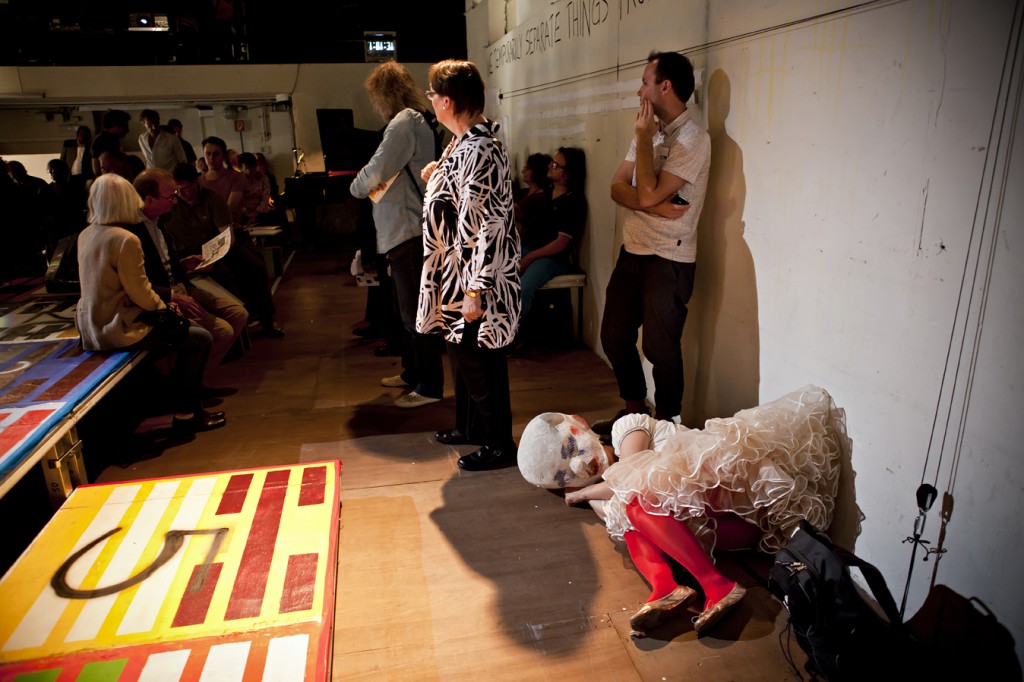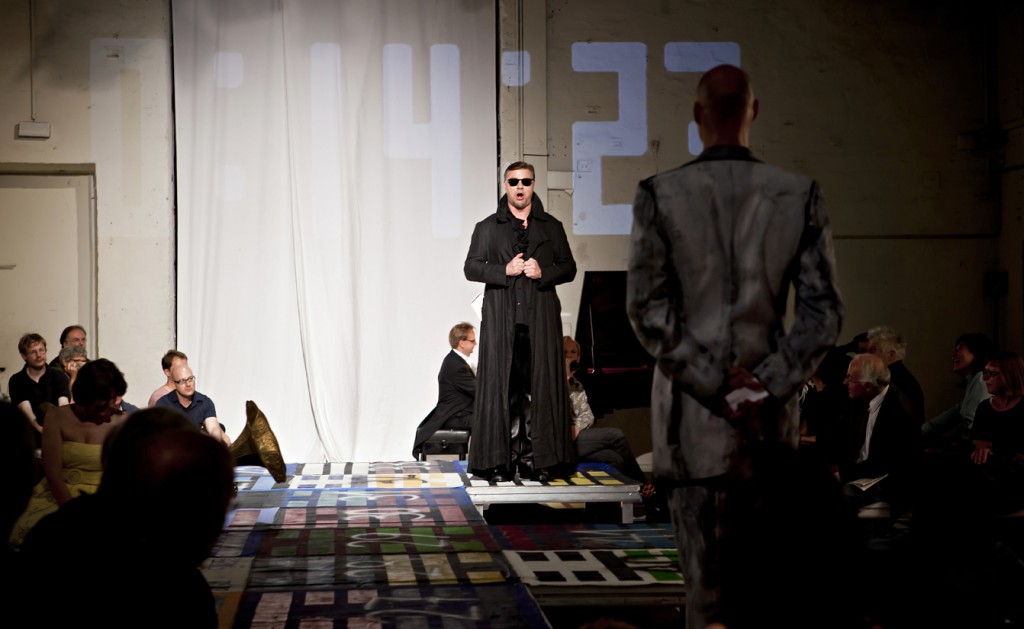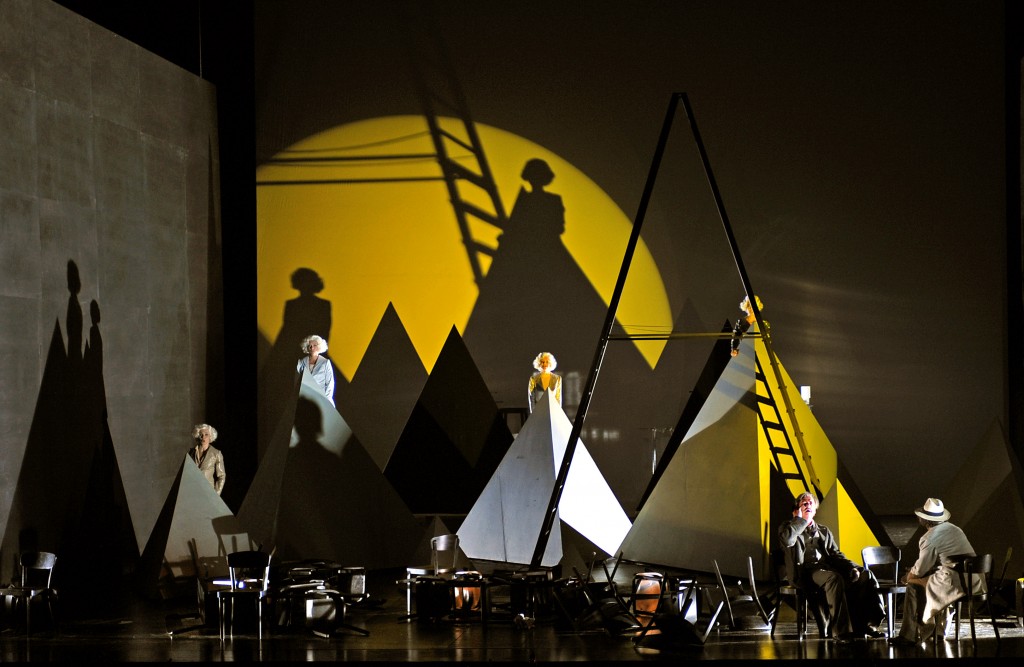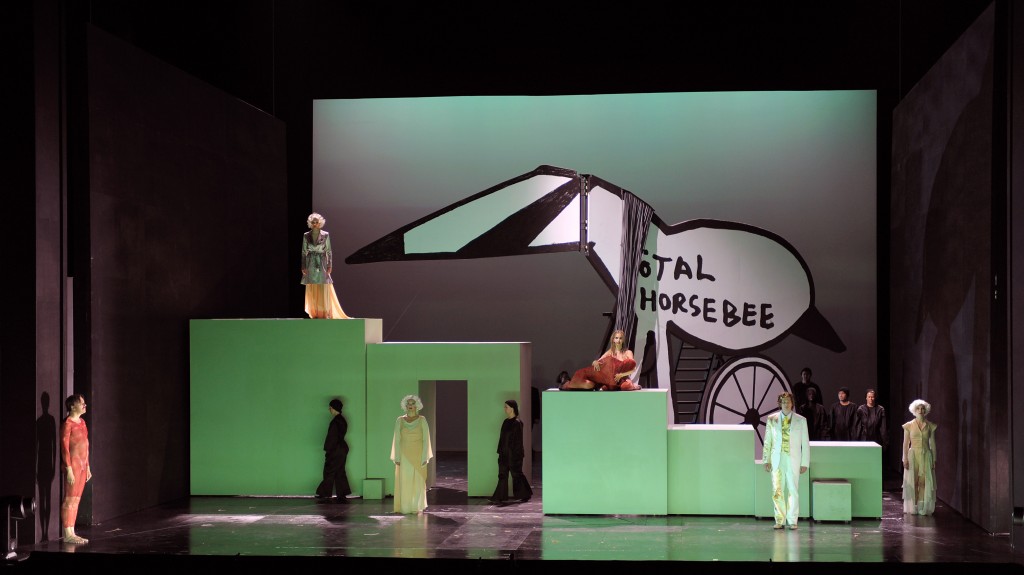By Rebecca Schmid
Infektion!, the name of the Staatsoper’s annual Festival for New Music Theater could easily extend to describe the presence of John Cage in Germany this year. No other country outside the U.S. has planned as many events for his centenary of his birth, and Berlin is in some people’s minds already ‘Caged out.’ The Akademie der Künste has been holding a multi-disciplinary, year-long retrospective since last fall; the annual new music festival MärzMusik dedicated itself to Cage and Consequences, flying in Joan La Barbara and the entire Sonic Arts Lounge. Cage’s works will take center stage next week in Darmstadt, where his 1958 visit “swept across the European avant-garde like a natural disaster,” in the words of German musicologist Carl Darlhaus. His Europeras 1&2, which premiered in Frankfurt in 1987 and received their last U.S. performance at the MOMA in 1992 (the year of Cage’s death), will be revived next month at the Ruhrtriennale. Meanwhile, at the Berliner Staatsoper, Die Musik ist los—100 Jahre John Cage (July 1-15) features six-hour evenings of Cage in ad hoc programming that includes his Europeras 3&4. The German premiere of Wolfgang Rihm’s Dionysus, a Salzburg Festival commission from 2010; a revival of the Staatsoper production of Stravinsky’s The Rake’s Progress; and a recital with Ian Bostridge are also officially part of the festival, just founded last year.
Cage’s Europeras, of which he wrote five altogether, are intended as a negation of opera, particularly in its synthesis of the arts into a Gesamtkunstwerk. “For 200 years the Europeans have sent us their operas,” the composer reportedly commented. “Now I am returning them all to them.” The first two include ten and nine singers, respectively, in extracts from over 60 operas, with sets and costumes that are meant coexist independently like objets trouvés. The third and fourth, which premiered in London in 1990, are more modest in scale: Europera 3 features six singers in a capella arias of his or her own choice, two pianists in excerpts from Liszt’s Opera Phantasien and 12 record-players, while Europera 4 dwindles to two singers, a wind-up gramophone, and a pianist. A ticking digital clock substitutes for a conductor to synchronize the Happenings, which overlap comically and sometimes irritatingly into a non-linear plot of sorts that is left to the viewer’s imagination.
Seen July 11 in the Werkstatt of the Schiller Theater, a small wing which the Staatsoper uses to stage new music theater, the singers walked onto strategically numbered platforms that also served as seats for the audience (most moved around at will). Unfinished excerpts of Liszt’s at times schmaltzy transcriptions yielded to the entrance of well-known arias, which were sometimes sung over more than one album of opera music. The cacophony built into a messy tapestry of sound that must be a challenge for even the best-trained singer; all were equipped with pitch forks, while the most prominent figure onstage, the soprano Esther Lee, in a tutu and giant plaster mask, had her iPhone (replete with a bunny-eared case) in hand for assistance. Singing one cameo aria after another, from “Dove Sono” to “Sempre Libera,” Lee eventually dropped dead, while a Papageno in leather pants (Roman Trekel) stepped over her in insouciance. This being anti-opera, the female heroine eventually rose for more drama (stage direction by Sophia Simitzis), although her booming timbre became increasingly metallic. Alfredo Daza assumed a kind of Don Giovanni figure as he cavorted around in a robe. He also broke out into the aria antica “O mio dolce ardor” so well-known to voice students, blocking his ear from the waves of Liszt emanating from the piano. Blaring record players intermittently asserted their dominance. Just toward the end of the 110 minutes, the theme from Die Walkyrie charged in unopposed, a satisfying close to an otherwise frustrating musical experience.
Europera 4 proved more redeeming in its simplicity (and brevity, clocking in at 30:00). The presence of René Pape was overwhelmingly powerful as he sang Sarastro’s arias from Die Zauberflöte, opening the production with “O Isis und Osiris” offstage. As he stood just inches away from the audience in a black cape at the center of the room, the immediacy of his rich, visceral tone, crisp diction, and emotional calm left this listener nearly speechless. The effect turned comic as he put on sunglasses and addressed Trekel with “In diesen heiligen Hallen” (stage direction by Isabel Ostermann). Trekel, emerging in an acid washed suit, had the audience in stiches as he sang through “Ra la la la, ra la la la, heisse Mutter, ich bin da.” The wind-up gramophone had its own comic appeal as old recordings interrupted wiltingly through the cylinder, while Pape continued to amuse as he sat at a baby grand to play air piano (a friend noted that everyone stopped paying attention to the actual pianist, Günther Albers, across the room). “Bella Figlia dell’Amore” was the last artifact to emerge from the gramophone before the lights fell.
The program continued unexpectedly with a Qi Gong session on the small lawn in front of the Schiller Theater, just in time for those emerging from the intermission of Dionysus to watch us in bewilderment. The non-hierarchical nature of the Happening, which transforms audience members into their own kind of spectacle, also fulfills the increasing demands on arts institutions for interactive audience participation. Despite some shades of absurdity, the fluid movement, stretching, and deep breathing (even if many weren’t wearing the right clothing) was in fact an ideal precursor to a performance of Nicholas Isherwood’s attempt at Japanese throat singing with a meditation bowl, echoed by another singer at the back of the Werkstatt theater space. One can only imagine how happy Cage would be to know that eastern forms of recreation are slowly finding common ground with European tradition, even if westerners continue to pose with their pretensions to worldly virtue, and that Berlin’s leading opera house indulges in such radical programming. The evening opened on a more clichéd note with a performance of 4’33’’ on a tiny toy piano outside the theater. Robert Farkas sat cross-legged playing silently as cars rumbled past, the original idea of mocking concert hall convention evolving into a more abstract, Cagean concept.
Dionysus
Wolfgang Rihm has become a familiar presence in the concert hall this season, starting with the Musikfest last fall and continuing with MärzMusik, which took his 60th birthday as an opportunity to posit his neo-Romantic idiom as an opposite ‘pole’ to Cage’s anarchic experimentalism—a perplexing bit of programming that nevertheless emphasizes both composers’ reactionary position with regard to the Darmstadt School. In contrast to Cage, who turned increasingly to chance operations and non-musical material in his last years, Rihm only seems to become more Romantic with age. His most recent stage work, the ‘fantasy opera’ Dionysus, takes Nietzsche’s Dionysus Dithrambs as well as the poem Klage der Ariadne as the basis for a self-devised libretto that explores the quest of N. (a character embodying both Nietzsche and Dionysus) for truth and in and out of his conflicted and, in this case, thoroughly nebulous relationship with Ariadne, whom according to Greek myth the god of wine and fertility seduced and deified. The opera, seen at the German premiere on July 8, opens to a sea where N. is taunted by nymphs, travels through Hades and ends on “A plaza. The horse. The skin.”—referencing Nietzsche’s exposure to the flogging of a horse that is said to have precipitated his mental breakdown. Apollo “a guest” accompanies N. only to taunt him: “I am also your labyrinth,” he tells Ariadne in the opening scene, while ensembles of sirens continue to reappear with teasing allure.
References to Mozart’s Die Zauberflöte appear in both the libretto and score, with a flute emerging prominently throughout the opera. The Wagnerian undertones also assert themselves from the opening scene (Rhine maidens) as well as in primordial, brooding harmonies, while Ariadne directly quotes Richard Strauss in the opening tableau. The opera’s quasi-philosophical precepts range from gripping to confounding. It is a journey through the mind of Nietzsche, his struggle to reconcile the destructive powers of an infinite quest for knowledge—“Selbsthenker (my own executioner)” N. repeats in the second tableau, while the ‘The Guest’ counters with “Selbstkenner (your own connoisseur)— yet Rihm also attempts to embed the highly erotic story of Dionysus and Ariadne into this dialectic, making the plot more labyrinthine than many viewers could handle. The music follows this pattern naturally, morphing freely from lush tonality into unsettling dissonance, such as in the female chorus “Tag meines Lebens” which suddenly transforms into a group of anti-sirens. The music in Hades teeters on the edge of insanity, yielding to a raw percussion interlude. As the conductor Ingo Metzmacher states in the program notes, no one knows his craft better than Rihm. The laughing staccato of nymphs in the opening tableau and sinister eroticism that emerges through his orchestration may place Dionysus firmly in the German Romantic tradition, and yet the score lacks the clear deliberation and cohesiveness of earlier stage works such as Proserpina , and even this score had a tendency to wind too freely through the rivers of Hades.
Sets by Jonathan Meese evoke a dark, expressionist fantasy world, drawing carefully upon the symbolism in Rihm’s text while bringing a provocative touch one would only expect from the German ‘enfant terrible.’ While the sloppy black and white drawings assigned to the Dionysian chorus and the “Total Horsebee” at the end are irritatingly tongue-in-cheek, the opening cliff on which N. rows to no avail and the giant bottle and beach balls in the brothel of the third tableau are deliciously imaginative despite the kitsch factor. Meese’s aesthetic was well-matched by Pierre Audi’s direction, who counters Rihm’s intellectual weight with subtly subversive humor. While the contrast was at times jarring and threatened to oversimplify the opera’s internal quest, Audi brought a fresh contemporary approach to a stage work that would have dragged its feet insufferably with a more cerebral approach. Costumes by Jorge Jara were at their height in the bulging female costumes of Hades; lighting by Jean Kalman created artful shadows and further propelled the opera into the realms of the unconscious.
Mojca Erdmann, in the role of Ariadne, proved why Rihm has found inspiration in her stratospheric if somewhat soubrette-like soprano, razor-sharp musicality and dramatic flexibility. A sprite seductress throughout, she inhabited the opera’s mercurial terrain with poise. Replacing Georg Nigl as N., James Cleverton, who also sang at the Salzburg premiere, convincingly conveyed the character’s emotional frustration vocally and dramatically. The tenor Matthias Klink was an effectively jeering Apollo despite some strain in the upper range. And yet the female voices ultimately sang the men offshore, with Canadian soprano Elin Rombo bringing smooth, full-bodied tones to the stage, complimented gloriously by mezzo Virpi Raisanen and alto Julia Faylenbogen in ensemble numbers. The Staatskapelle performed incisively yet with calm expressivity under Metzmacher, Germany’s leading conductor for new music, also testifying to the quality that Daniel Barenboim has cultivated as music director of this orchestra. The musicians brought velvety phrasing to Straussian turns while following Metzmacher’s precise conducting through the unpredictable contours of Rihm’s score, which expired into dust after failing to help N. find his way.
Tags: Akademie der Künste, Alfredo Daza, Carl Darlhaus, Daniel Barenboim, Darmstadt, Die Zauberflöte, Dionysus, Don Giovanni, Elin Rombo, Esther Lee, Europeras, Frankfurt, Günther Albers, Infektion!, Ingo Metzmacher, Isabel Ostermann, James Cleverton, Joan La Barbara, John Cage, Jonathan Meese, Jorge Jara, Julia Faylenbogen, Liszt, MärzMusik, Matthias Klink, Mojca Erdmann, MOMA, mozart, Nicholas Isherwood, Nietzsche, Pierre Audi, Proserpina, Qi Gong, René Pape, Robert Farkas, Roman Trekel, Ruhrtriennale, Salzburg Festival, Schiller Theater, Sonic Arts Lounge, Sophia Simitzis, Staatsoper Berlin, Virpi Raisanen, wagner, Walkyrie, Wolfgang Rihm



